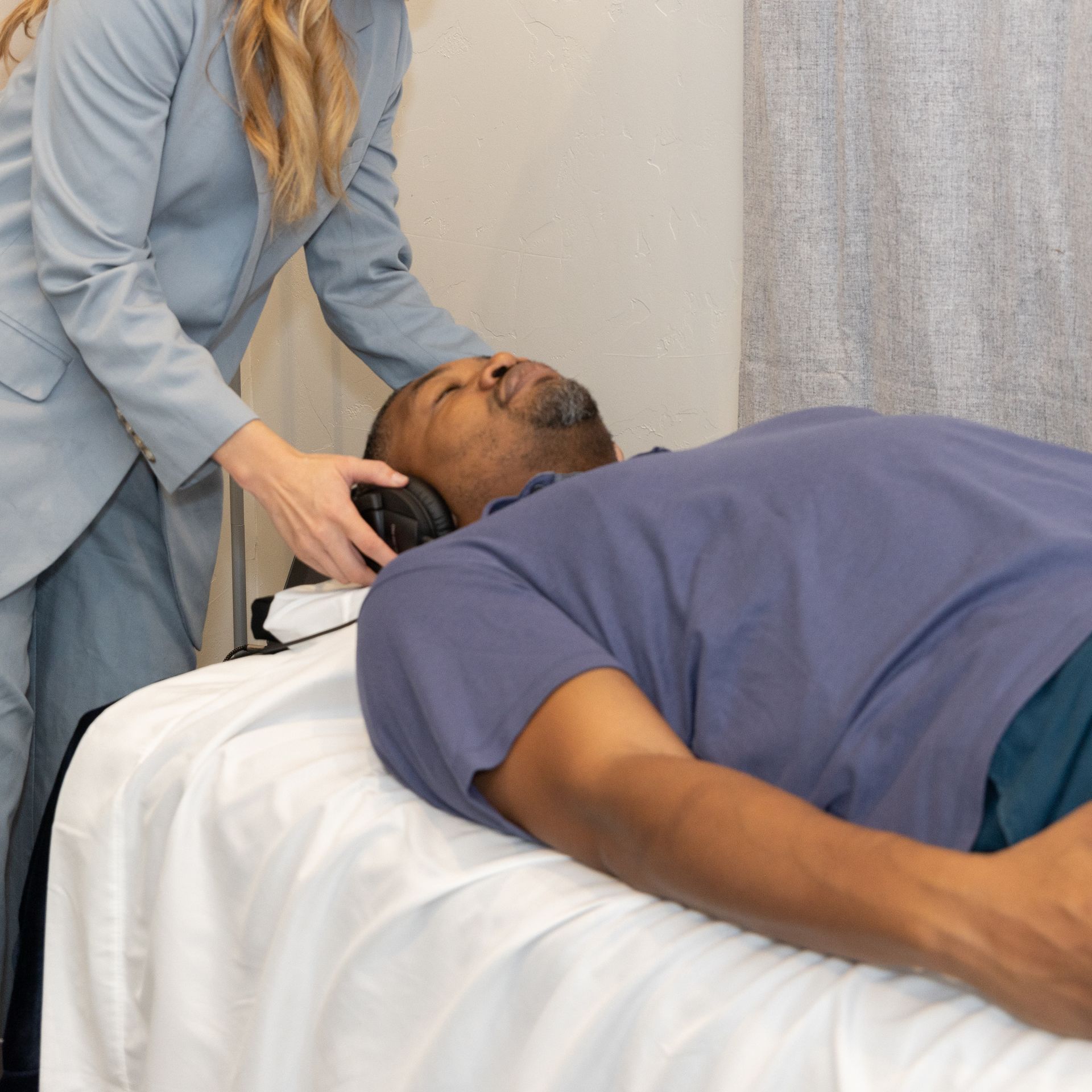EMDR vs Brainspotting
Some of our favorite wellness products for you to check out.
Vibroacoustic Therapy
Inharmony products for at home use
Use our code WellnessNSC
to receive 5% off your purchase
Learn how Essentials oils can boost your Brain and Body Health
Turn on the body’s ability to heal with this all-natural essential oil blend made from a synergistic combination of clove and lime essential oils. Melt away stress, elevate mood, boost energy, improve digestion, and regain focus with Parasympathetic®.
Choosing the Right Trauma Therapy: EMDR vs. Brainspotting
What is EMDR?
EMDR, developed by Francine Shapiro in the late 1980s, is rooted in the "Adaptive Information Processing (AIP) model", which suggests that traumatic memories become "stuck" in an unprocessed state, causing distress and dysfunction. EMDR helps reprocess these memories through an eight-phase protocol, utilizing "bilateral stimulation"—most commonly, "smooth pursuit eye movements" guided by a therapist. To learn more about Bilateral or Biolateral Music stimulation visit our Blog on the use of Bilateral Music.
The process involves:
1. Identifying a distressing memory.
2. Associating it with negative beliefs, emotions, and bodily sensations.
3. Reprocessing the memory using guided eye movements or other bilateral stimulation until its emotional charge decreases and positive beliefs emerge.
EMDR has been around longer than Brainspotting, and so is well-supported by research and widely used in trauma-focused therapy. It emphasizes cognitions, targeting negative and positive beliefs about oneself while engaging both the neocortex (the thinking brain) and the subcortex (the emotional brain).
What is Brainspotting?
Brainspotting, founded by David Grand an EMDR practitioner in 2003, takes a more "relational and experiential" approach. It is built on the "Neuroexperiential Model" and emphasizes accessing the "subcortex"—the deeper brain regions associated with emotions, memories, and survival instincts. I find that this approach does help clients gain deeper access to the brain and helps to process stuck emotions and experiences.
Unlike EMDR, which relies on continuous eye movements, Brainspotting uses "fixed eye positions" to identify and process trauma. As a clinician I collaborate with the client to locate a "brain spot"—a specific eye position that correlates with stored trauma, stuck physical sensations, or emotional activation. This process is deeply attuned and allows clients to process at their own pace within a flexible, frame-based structure. The highly attuned model is helpful in healing attachment wounds.
Brainspotting draws on the "Uncertainty Principle", which acknowledges the therapist's inability to fully know what a client will experience during the process. Really, there are over a quadrillion neural networks in the brain. Can we know what is happening in the brain? This principle fosters an open and client-led exploration, bypassing the cognitive brain to work directly with the subcortex. If people could think their way to change they already would have.
Key Differences Between EMDR and Brainspotting

- Eye Movements vs. Fixed Gaze:
EMDR uses smooth eye movements to facilitate memory reprocessing.
Brainspotting relies on maintaining a fixed eye position to access deeper emotional processing.
- Attunement and Relational Focus:
Brainspotting emphasizes a high level of attunement between therapist and client, creating a deeply relational experience.
EMDR follows a structured protocol, which may feel less relational but offers a predictable framework for treatment.
- Cognitive vs. Subcortical Processing:
EMDR engages both the neocortex (thoughts) and subcortex (emotions), often incorporating cognitive interweaves and focusing on belief changes.
Brainspotting bypasses the neocortex entirely, aiming to process trauma stored in the subcortex and body. Brainspotting at the end then takes the information from the subcortex and engages with the neocortex.
- Protocol-Based vs. Frame-Based:
EMDR follows a specific eight-phase protocol.
Brainspotting is more flexible and adaptable, operating within a "frame" that evolves based on the client's needs.
- Theoretical Foundations:
EMDR is rooted in the "AIP model" which explains how memories are processed and reprocessed.
Brainspotting uses the "Neuroexperiential Model", emphasizing the brain-body connection and experiential healing.
- Developmental Focus:
Brainspotting addresses developmental trauma, including generational, intrauterine, birth, and preverbal experiences.
EMDR typically focuses on explicit, conscious memories and does not delve into preverbal or generational trauma as explicitly.
How to Choose Between EMDR and Brainspotting
When deciding which approach is right for you, consider the following factors:
- Nature of the Trauma
- If your trauma is tied to specific, explicit memories (e.g., a car accident or a single-event trauma), EMDR may provide a more structured and rapid resolution.
- If your trauma feels diffuse, preverbal, or somatically rooted, Brainspotting may be better suited to access and release deeply held emotional pain.
- Preference for Structure vs. Flexibility
- EMDR offers a clear and systematic approach, which may appeal to those who prefer a roadmap for healing.
- Brainspotting is more fluid and relational, making it a good fit for clients who value adaptability and a highly personalized experience.
- Relational Needs
- If you value a deeply attuned therapeutic relationship where the therapist’s presence is highly integrated into the process, Brainspotting may resonate more.
- If you’re comfortable with a more structured, directive approach, EMDR might be a better choice.
- Cognitive vs. Experiential Focus
- EMDR engages your thoughts, beliefs, and emotions, helping to reframe negative cognitions.
- Brainspotting allows you to process without overthinking, focusing on what your body and brain reveal.
What Should You Look for in a Therapist?
Regardless of the method, the therapist’s expertise, attunement, and ability to create a safe, nonjudgmental space are crucial. Here’s what to consider:
- Training and Certification: Ensure the therapist is certified in either EMDR or Brainspotting and has experience working with trauma.
- Specialization: Some therapists are trained in both modalities and can tailor sessions to your needs. Make sure they have experience and training in what resonates for you. Both modalities don't guarantee that the therapist specializes in your needs. So make sure to ask!
- Compatibility: Trust your intuition when choosing a therapist. Feeling safe and understood is vital to the healing process. Take advantage of complimentary consultations and interview the therapists.
What’s Best for You?

There’s no universal answer—it depends on your unique needs and preferences. Some clients find immense relief with EMDR’s structured approach, while others thrive in the relational and experiential depth of Brainspotting. Still, others benefit from a combination of both.
It’s worth noting that both methods aim to help you heal by accessing the brain’s natural capacity to process and release stuck experiences. The journey might look different, but the destination—a life unburdened by past pain—is the same.
Choosing the right therapy can feel overwhelming, but it’s important to remember that both EMDR and Brainspotting are effective, evidence-based approaches. Take the time to research, consult with trained therapists, and reflect on your own needs and preferences.
Trauma recovery is deeply personal, and the right approach is the one that resonates with you and feels supportive in your healing journey. Both EMDR and Brainspotting offer unique pathways to peace and resilience—whichever you choose, you’re taking a powerful step toward transformation.
Meet
Our Therapists
-
Cherie Spellman
Learn More about CherieLMFT-S
Brainspotting Consultant
-
Elizabeth Moore
Learn more about ElizabethMarriage and Family Therapy -Associate Supervised by Cherie Spellman
-
Katie Trillos
Learn more about KatieLCSW
EMDR and Brainspotting Therapist
Previous Blogs







Interested in our services? We’re here to help!
We want to get to know your needs so that we can provide the perfect solution. Give us a call today and we’ll do our best to help.





















